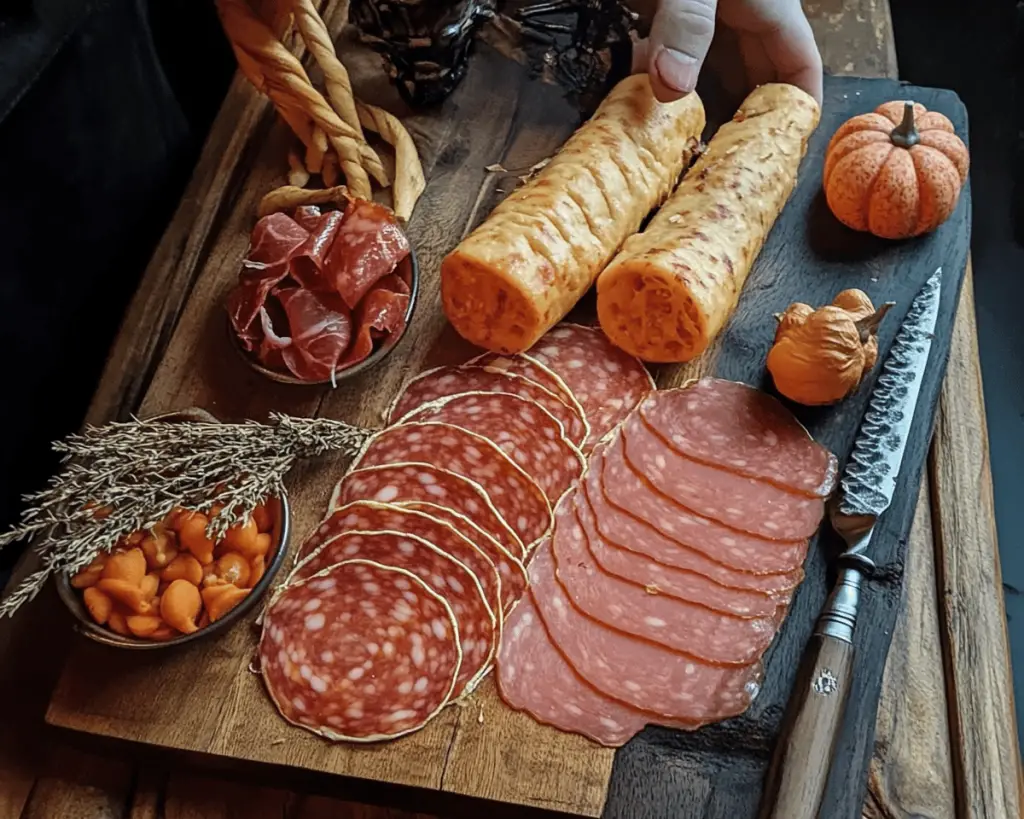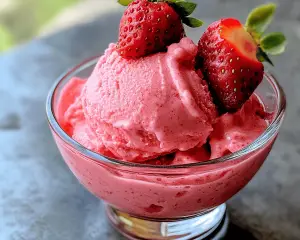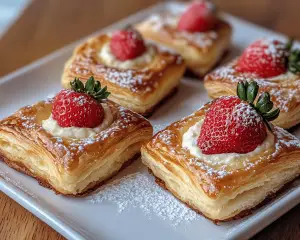In the world of festive gatherings and culinary creativity, Halloween brings forth an uncanny wonder — an invitation to embrace the eerie and the whimsical. Over the years, I’ve made countless seasonal treats, but it was during a particular Halloween soirée with friends that I stumbled upon a delightful concoction: the Charcuterie Hand. This dish, as macabre as it sounds, is a showstopper on any Halloween table, half charming and half chilling.
Picture this: gathering with friends, laughter filling the dimly lit room, the shadows dancing on the walls from flickering candlelight. The table, enlivened by the colors of fall, offers a spread of delicacies, but one creation stands out — a hand made of cured meats, cheeses, and assorted nibbles, laid out as if beckoning guests with otherworldly allure. It was the hit of the night and has since become a beloved tradition in my own kitchen, a culinary homage to the spirit of Halloween.
As I set out to create my Charcuterie Hand each year, I come alive with excitement, not merely for the taste, but for the artistry it embodies. Each ingredient blends in a tapestry of flavors and textures that can both impress and amuse. This delightful dish is an opportunity for storytelling — each element whispers secrets of its ingredients and celebrates the act of eating together, an essential ritual that knits bonds of friendship and love, especially during a time when the veil between the ordinary and extraordinary feels particularly thin.
Inside the Ingredients of Charcuterie Hand
Creating this eerie yet delightful Charcuterie Hand begins with an appreciation for its essential ingredients. Each element plays its role in contributing to the visual and gustatory experience.
Prosciutto is the foundation of my Charcuterie Hand. This Italian dry-cured ham, with its rich, savory flavor, can be both delicate and bold, depending on how it’s sliced. Layers of prosciutto wrapped around a hand-shaped mold create the base form. Many friends and family have asked if I make my own, adding an air of seriousness to the endeavor, but I assure them that high-quality store-bought prosciutto elevates this piece just as well. If you’re looking for a substitution, finely sliced salami could provide a similar savory depth, though the texture won’t be quite the same.
Next, I turn to cheddar cheese and brie. The sharpness of cheddar beautifully contrasts with brie’s creamy richness; they are both favorite components in any charcuterie spread. They not only enhance flavor but also offer a dramatic visual — the cheddar cubes form knuckles, while brie can provide a hint of softness for the palm. If you lean towards a vegan rendition, cashew cheese or a well-aged vegan cheddar can make for surprisingly delightful alternatives without compromising on texture.
Olives, typically green, become the perfect touch for fingernails. Their glossy skin reflects the faint light, and their briny taste adds just the right contrast to the rich and savory profile of the hand. I’ve also found that roasted red peppers, cut into an elongated shape, can serve as a striking substitution or addition to this tactile festivity.
Moving on to the crunch, I fondly remember the times when my grandmother taught me to appreciate nuts — almonds and walnuts sprinkled across the board create an inviting texture that encourages snacking. They make for a nourishing component and add an earthy richness. Should you have nut allergies among your guests, roasted chickpeas can be a fun, crispy alternative that mimics that satisfying crunch while offering protein.
Then there are the grapes. These lovely orbs of sweetness counterbalance the savory flavors, connecting the hand with the mouthfuls of joy and laughter shared around the gathering _ as they reflect both sweetness and the spirit of the harvest season. I often use a mix of green and red grapes; their contrasting colors add a pop of vibrancy to this spooky approach to charcuterie.
Finally, to bind it all together, a selection of crackers or a rustic loaf of bread serves as the perfect accompaniment, enhancing the experience of each bite. They act as a canvas, transforming our hand of meat and cheese into an interactive feast. The rise of gluten-free products has made it possible for everyone to enjoy the installation, making this dish still feel inclusive.
How Charcuterie Hand Fits Into a Balanced Life
While the Charcuterie Hand seems festive and fun, it also offers surprisingly beneficial nutritional aspects when curated mindfully. It intertwines enjoyment with balance, and when I serve it, I remind my guests that food is a celebration of life.
Starting with the protein sources, cured meats like prosciutto and cheeses like brie and cheddar deliver essential amino acids, vital for muscle repair and overall health. Packing a protein punch has never felt so indulgent, especially at a time of year often filled with sweets and less nutritious fare.
The inclusion of fruits like grapes and the addition of crunchy vegetables can provide dietary fiber, keeping our digestive systems happy and contributing to the feeling of fullness. Fruits, in particular, offer antioxidants that support our immune systems — something we could all benefit from during the colder months as the seasons change.
I love the way this dish can be a canvas for culinary creativity while emphasizing less processed options. You can sprinkle in some fresh herbs like rosemary or thyme that not only enhance flavor but add visual appeal with their vibrant green hues. These herbs carry aromatic and medicinal properties that can help uplift moods, which feels particularly apt during the Halloween season where we celebrate all things mysterious and mystical.
It’s important to remember that balance doesn’t mean depriving oneself of pleasures. Rather, it’s about allowing room for indulgence while incorporating wholesome elements. On occasion, I’ve invited guests to help themselves to even more seasonal delights alongside the Charcuterie Hand — think roasted pumpkin seeds or sweet potato chips for that additional crunch. They’re welcomed additions that bring the elements of fall even closer to this delightful centerpiece.
What You’ll Need
– 8 oz. of prosciutto
– 8 oz. of brie
– 8 oz. of cheddar cheese
– 1 cup of mixed olives
– 1 cup of grapes (mixed varieties)
– 1 cup of raw nuts (almonds, walnuts)
– Assorted crackers or a small loaf of rustic bread
– Optional: fresh herbs for garnish
This recipe serves 8-10 people and is perfect for a festive gathering where mingling is inevitable and plates may overflow with swift snacking.
Preparing Charcuterie Hand Step by Step
Making a Charcuterie Hand is less about strict measurements and more about the creation of a visual experience that tells a story, and as I guide you through the steps, feel free to unfold your creativity!
1. **Create the Hand Loom**: Start with a baking sheet or cutting board as your base. To create the shape of a hand, I’ve used a silicone mold designed for hand shapes — this allows you to layer the prosciutto smoothly. If you don’t have a mold, simply forget perfection and sculpt your hand by arranging the meats and cheeses on the board.
2. **Shape With Prosciutto**: Begin laying down slices of prosciutto, starting at the base of the fixed palm. Overlap the slices slightly to ensure they adhere to one another well, creating a sturdy base. Work your way up to the fingers, remembering to save some for the knuckles and end of the fingers.
3. **Constructing the Palm**: Once the wrist is carved out, layer slices of your cheeses. First, lay thick cuts of brie in the palm area, and then arrange cheddar around the edges. Aim for that organic look – it should feel inviting rather than overly structured!
4. **Crafting the Fingers**: For the fingers, you may want to use smaller cubes of cheddar for knuckles and slice small pieces of brie to create the fingertip look. Here, your artistry shines — cut the cheese pieces to mimic fingernails and arrange them adorably.
5. **Add the Olives and Grapes**: Now comes the fun part! Place olives carefully on the tips of the prosciutto fingers — you can even pick green and black olives for a contrast of colors. Scatter grapes around the palm, creating a touch of cheerfulness.
6. **Sprinkle the Nuts**: Next, add your nuts around the wrist area, providing a crunchy texture and an inviting pop to the hand spread.
7. **Finish with Crackers and Bread**: Finally, present a selection of crackers and some toasted bread pieces next to your hand, inviting guests to take their share. Consider decoratively positioning some fresh herbs to enhance presentation and taste.
8. **Serve and Enjoy**: Once your masterpiece is complete, step back and admire your work! Serve this creation at your gathering and enjoy the reactions of your guests — almost as delightful as the flavors themselves.
Lessons from My Kitchen
Every chef knows that cooking isn’t always about precision; it’s about evolution in the kitchen, blending seasons together, and learning from curiosity and trial. My first attempts at the Charcuterie Hand were a bit, let’s say, rudimentary. I recall a time when I didn’t understand how the arrangement of flavors could change everything. I stacked up ingredients somewhat haphazardly on the plate without much thought to the aesthetics. And while it tasted good, it lacked that captivating charm that initially drew me into this culinary art.
Time taught me to pay attention to detail, to think of each ingredient not merely as sustenance, but as part of a story that unfolds on the plate. My mom always said, “Good food and good company are the two essentials of a joyful life.” As I prepared ingredients for the hand this year, I remembered her sage advice, which has been echoed through my culinary ventures.
Over the years, I’ve played with themes beyond Halloween for my Charcuterie Hand. On one occasion, I crafted a Thanksgiving hand, using turkey slices, cranberry bits, and a wide assortment of local cheeses with the same artistic flair. The key is rhythm, pattern, and the willingness to embrace unexpected variations. If I learned anything, it’s that cooking, much like life, is a journey — let it evolve, explore, celebrate creativity, and don’t shy away from whimsical ideas.
As we move into fall, the theme of the Charcuterie Hand can further adapt — think roasted apples and sharp cheeses for a harvest look or incorporate seasonal squash for those into a more rustic presentation. The flavors that change and the colors of the ingredients remind us of the seasons as they dance around us, just like the pumpkin patches waiting to be explored.
In closing, my invitation to you is this: explore the art of the Charcuterie Hand in your own kitchen. Let it grow from your memories, laughter, and the creativity you find in cooking. This dish could become a beloved centerpiece as it was in mine, not just as a haunted delight for Halloween but as an ever-changing canvas in your culinary repertoire. Embrace the sculpturesque nature of food, and in doing so, celebrate the connecting power of sharing meals — for it is in these moments that we discover joy, warmth, and the heart of cooking itself.



